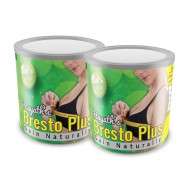Breast enlargement

Bresto Plus, a breast enlargement supplement
Breast enlargement is the enlargement of the breasts. It may occur naturally as in mammoplasia or may occur artificially through active intervention. Many women regard their breasts, which are female secondary sex characteristics, as important to their sexual attractiveness, as a sign of femininity that is important to their sense of self. Due to this, when a woman considers her breasts deficient in some respect, she might choose to engage in some activity intended to enhance them.[1]
Methods used in an effort to achieve larger breasts include:
- Surgical breast augmentation, such as with breast implants or fat transfer.
- Hormonal breast enhancement, through experimental administration of hormonal agents such as estrogen.[2]
- Herbal breast enlargement supplements, pills or other ingested substances containing herbs asserted to increase breast size hormonally.
- Increasing the food energy intake by eating more and/or more energetic foods. By increasing your food energy intake, more adipose tissue will be created, part of which will consist of adipose tissue located near the breast area.[3]. The amount of adipose tissue that will be added to the breasts varies from person to person and is controlled by the KLF14 gene.[4]. Additional modification of the KLF14 gene can thus make sure even more of the adipose tissue increase will occur at the breasts.
- Mechanical breast enhancement, such as through use of the BRAVA Breast Enhancement and Shaping System, a clinically-effective external breast tissue expander.[5]
- Mark Eden bust developer, a fraudulently marketed method and device.
See also
References
- ↑ "Secondary sex characteristics". .hu-berlin.de. Retrieved 2011-10-31.
- ↑ Hartmann BW, Laml T, Kirchengast S, Albrecht AE, Huber JC (1998). "Hormonal breast augmentation: prognostic relevance of insulin-like growth factor-I". Gynecol. Endocrinol. 12 (2): 123–7. PMID 9610425. doi:10.3109/09513599809024960.
- ↑ Contribution of breast volume and weight to body fat distribution in females
- ↑ Identification of an imprinted master trans-regulator at the KLF14 locus related to multiple metabolic phenotypes
- ↑ Schlenz, Ingrid; Kaider, Alexandra (2007). "The Brava External Tissue Expander: Is Breast Enlargement without Surgery a Reality?". Plastic and Reconstructive Surgery. 120 (6): 1680–1689. ISSN 0032-1052. PMID 18040206. doi:10.1097/01.prs.0000267637.43207.19.
This article is issued from
Wikipedia.
The text is licensed under Creative Commons - Attribution - Sharealike.
Additional terms may apply for the media files.